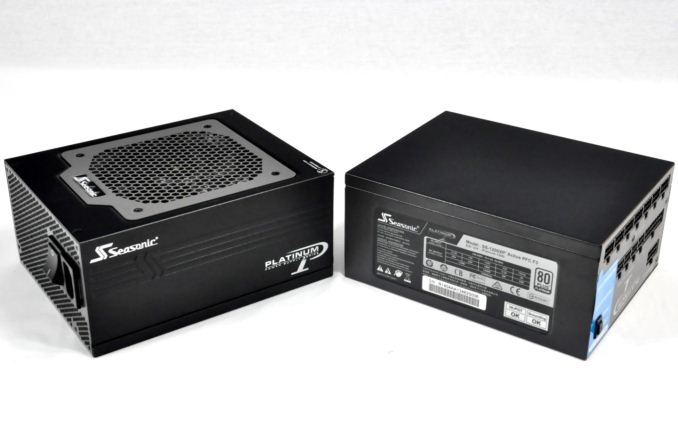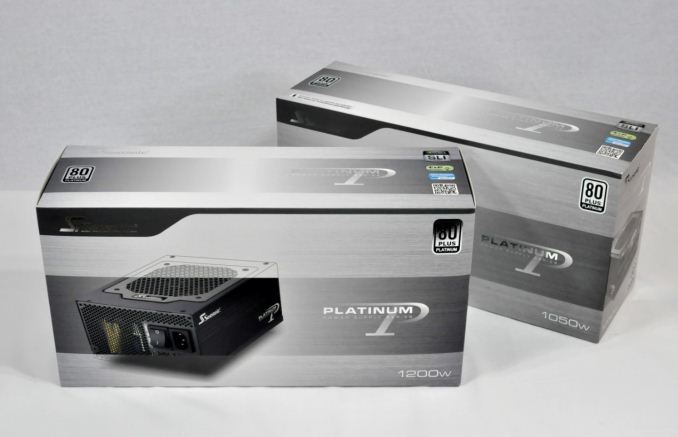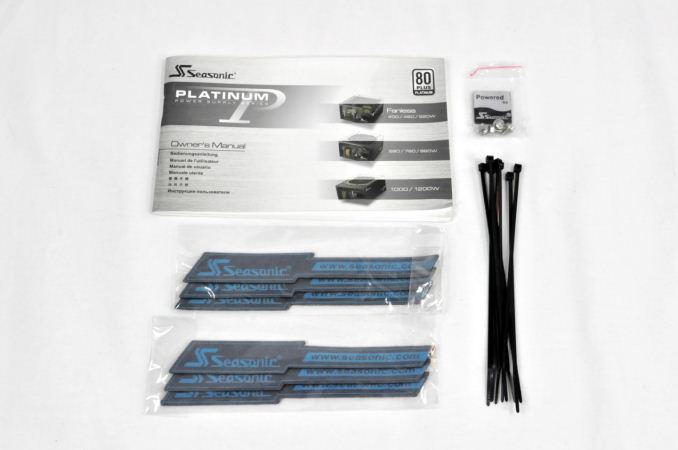Seasonic Platinum SS-1050XP3 & SS-1200XP3 Power Supply Review
by E. Fylladitakis on September 3, 2014 6:00 PM EST- Posted in
- Cases/Cooling/PSUs
- Seasonic
- 1200W
- 80Plus Platinum
- 1050W

Introduction
The 80 Plus program was introduced a decade ago with the aim of promoting the development of more efficient and environmentally friendly computer PSUs. Since then, it has undoubtedly become one of the favorite subjects of PSU marketing teams. Not long ago, an 80 Plus Bronze certification was more than adequate for a mainstream product, with 80 Plus Gold certifications reserved for premium product ranges. Today, 80 Plus Gold certified units can be found retailing at very reasonable prices, slowly but surely making the 80 Plus Bronze certification fit only for low-range products.
There also are numerous 80 Plus Platinum certified products available and even a few 80 Plus Titanium certified units, such as the Corsair AX1500i, are making their appearance, albeit their ludicrous price tags. Meanwhile, the pricing of 80 Plus Platinum certified PSUs has become more reasonable, allowing the manufacturers to effectively implement the technology in their medium and high-end units. Today we have a couple more 80 Plus Platinum PSUs on our test bench.
Seasonic is a very well-known manufacturer of high quality PSUs, so they hardly need an introduction. Today, we are going to look at two of the new additions to their Platinum series, the Platinum SS-1050XP3 1050W and the Platinum SS-1200XP3 1200W. The name of the series is obviously linked with the 80 Plus Platinum efficiency certification of the units and it is their top-tier series, so these two new models also are the best consumer-grade PSUs that Seasonic currently offers. The 1050W and 1200W versions currently retail for $230 and $250 respectively, which are fairly reasonable prices considering their class and power output. How well can they perform though? We will find out in this review.
| Platinum SS-1050XP3 - Power specifications ( Rated @ 50 °C ) | |||||
| AC INPUT | 100 - 240 VAC, 50 - 60 Hz | ||||
| RAIL | +3.3V | +5V | +12V | +5Vsb | -12V |
| MAX OUTPUT | 25A | 25A | 87A | 3A | 0.5A |
| 125W | 1044W | 15W | 6W | ||
| TOTAL | 1050W | ||||
| Platinum SS-1200XP3 - Power specifications ( Rated @ 50 °C ) | |||||
| AC INPUT | 100 - 240 VAC, 50 - 60 Hz | ||||
| RAIL | +3.3V | +5V | +12V | +5Vsb | -12V |
| MAX OUTPUT | 25A | 25A | 100A | 3A | 0.5A |
| 125W | 1200W | 15W | 6W | ||
| TOTAL | 1200W | ||||
Packaging and bundle
We received both units in a long, very well designed cardboard box, with an elegant brushed metal color theme and reflective lettering. Inside the thick cardboard walls of the box, the unit is protected by Polyethylene foam pieces and is wrapped inside a synthetic cloth pouch, which can be repurposed. Information on the performance and the features of the unit can be found on the back of the box.
Both units share the same bundle, consisting of a well written manual, a case badge, four typical 3M mounting screws, a few cable ties, and six cable straps. We imagine that many enthusiasts would prefer black screws instead, but that is a minor misstep.
Both units share almost the same set of cables as well, with the exception that the 1200W version offers ten 6+2 pin PCI-E connectors instead of eight. The cables come supplied in a dual compartment nylon bag with the series logo printed on both sides. With the exception of the 24-pin ATX cable, all of the cables are flat, ribbon-like cables with no sleeving. The 24-pin ATX cables uses black wires as well, but they are individual wires and are covered with black sleeving.














39 Comments
View All Comments
Impulses - Thursday, September 4, 2014 - link
I'm not sure I buy that NV and AMD are putting efficiency at the forefront, seems it's kinda cyclical for each ands then they regress.Case in point, I recently had to buy a new PSU because the 750W that could easily handle two AMD HD6950 in CFa couple years ago wouldn't be enough for two new R9 290. Ended up with a Seasonic X-1250 just because it was on sale (was looking at 1K units otherwise).
Seasonic's biggest competition seems to be themselves (they now have three top end lines? the Gold X models and two Platinum lines?) and the various brands that resell Seasonic designs (XFX etc).
romrunning - Thursday, September 4, 2014 - link
I'm curious - how much power does your system actually draw?A link here (http://www.anandtech.com/show/8422/amd-announces-r... said the R9 290 draws 250W. Even if they spike to 275-300W under heavy load, you still have 150W for everything else. Are you running a 220W AMD CPU or something?
Impulses - Friday, September 5, 2014 - link
I could maybe get away with the 750W unit, but I wasn't really looking forward to running it at 100% load thru hours of gaming, and/or unexpected crashes while OC'ing etc.DanNeely - Thursday, September 4, 2014 - link
There's something wrong with the -12V column in the table. 3A @ -12V would be 36 watts of power not 6. 3A also seems unusually high for a current generation model.E.Fyll - Thursday, September 4, 2014 - link
Thank you for pointing that out Dan. The 5VSB and -12V columns were reversed, that was a typo mistake on my part.WilbertCane29 - Friday, September 5, 2014 - link
I found this to be really interesting. Are there any more sources on this? I would like to know more about this.Oxford Guy - Wednesday, December 3, 2014 - link
Typical review site doublespeak:The power supply can be "ear splitting" and "be heard from rooms away" but:
"we do believe that very few users actually require their system to remain silent while it is heavily loaded."
Give me a freakin' break. 50+ db is related to a desire for silence how, exactly? Not having something cause someone to develop tinnitus during the warranty period has to do with a quest for silence how, exactly?
"it is known that such powerful units have a very limited target audience."
Yes, the deaf.
Oxford Guy - Wednesday, December 3, 2014 - link
It's long past time for these antique standards like ATX with 120mm fans be replaced. If you're going to provide 1000 watts of power or more, move to a new form factor. How about a 200mm fan with a vapor chamber?Think outside of the bloody box! And, stop apologizing for these poor thoughtless designs. This power supply is unsuitable for use out side of a server room.
Oxford Guy - Wednesday, December 3, 2014 - link
It pisses me off to no end to see the same regurgitation of anachronism year after year, with the most miniscule changes being hailed as great innovation. Why can't companies actually innovate?Make the entire top of a PC case a triple width 360mm radiator instead of these absurd tower designs with redundant narrow radiators and fans splattered all over the place, competing with each other. Link in the GPUs, the CPU, the motherboard VRMs, and the power supply with heat pipes and a giant vapor chamber. Do something instead of this piecemeal and pathetic series of attempts to shoehorn high wattage equipment into form factors that don't work.
I remember when Apple told people to drop their Apple IIIs onto desks to reseat the chips that popped out from heat — because Apple designed the case to be oh-so-pretty before it finished engineering the internals! This is the same nonsensical mentality that dominates the "enthusiast" equipment industry and review sites' appraisals. The assumption is that the form factors already exist and must be slavishly followed, no matter how idiotic the result.
But, while I sit around unemployed in disgust in the midst of cornfields I get to see the parade of banality continue...
I realize that Silverstone has done a bit with its triple and dual 180mm fan rotated designs but those are not adequate for really quiet computing with high wattage multiple GPU machines. People even suggest pairing blower GPUs with those cases. Blower GPUs! Blowers on GPUs should have been consigned to the relic bin 10 years ago. Sure... let's pair a high wattage part with a teeny tiny little fan and form factor. Then, let's put two or three into the system to double or triple the stupidity. That makes sense!
Linked heat pipes, linked radiators, big vapor chambers, single air path, the case acting as a heat sink as well... Centralized non-redundant non-competitive cooling mechanisms. That is the future, not more of the same 50+ db just for the power supply BS, teeny tiny fans, 5 or 6 airflow paths in different directions, and general anachronistic chaos disguised as cleverness.
I know it makes more money for manufacturers to keep people in the upgrade mouse wheel, trying to get a decent product by cobbling together all the half-hearted efforts but it's time to start delivering a holistic well-made product without paying Mac Pro prices or worrying about Apple's obsession with glamour.
Get with it, people.